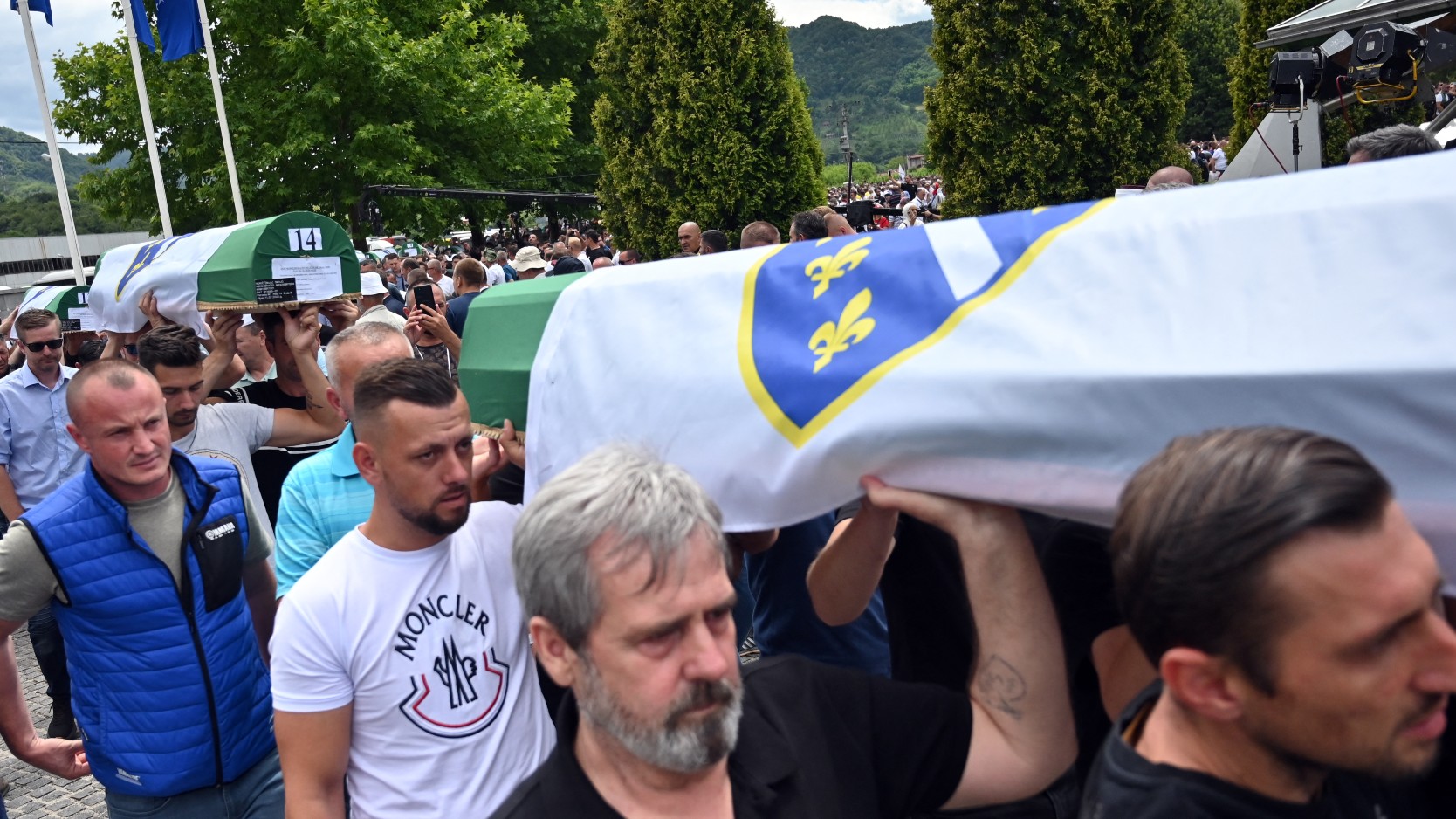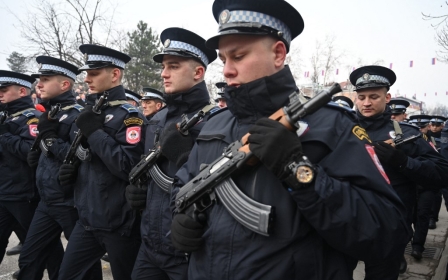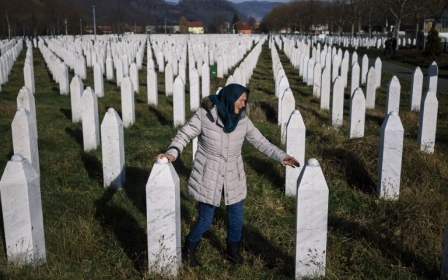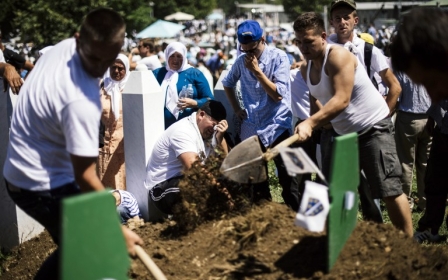Srebrenica: 27 years after and still fighting genocide denial

This week marks the 27th anniversary of the genocide in Srebrenica, known to be the worst atrocity in Europe since World War II. In July 1995, more than 8,000 Bosniak (Bosnian Muslim) boys and men were systematically executed in just a few days.
When the Serb forces led by Ratko Mladic took over a United Nations "safe area" of Srebrenica, they separated the men and boys from the women and girls. They then led the boys and men to the fields shot them and then pushed them into mass graves with bulldozers.
On the day of the anniversary this year, 49 victims of the genocide in Srebrenica will be buried
Reports suggest that some were buried alive, while other adults were forced to watch their children be killed.
In order to hide the evidence, the bodies were dug up and transferred by trucks and mechanical diggers to several “secondary” and even “tertiary” mass graves, each one farther away from where they were originally buried.
Some survivors had to pretend to be dead and hid under corpses.
New MEE newsletter: Jerusalem Dispatch
Sign up to get the latest insights and analysis on Israel-Palestine, alongside Turkey Unpacked and other MEE newsletters
Srebrenica was a shelter to tens of thousands of internally displaced Bosnian Muslims who fled the attacks of Bosnian Serb forces on their towns and villages in eastern Bosnia, including my maternal grandfather.
The town was declared “a safe area…free from any armed attack or any other hostile act” in April 1993 by the UN Security Council. But it was suffocated by the Serb siege, which controlled supplies for the enclave, and a number of Bosniaks died of starvation.
During the evacuation of mostly women and children, many women and girls were taken out of the queues of evacuees and raped.
The 'death road'
Realising they would not be protected, around 15,000 Bosniaks, mainly men and boys, and a small group of women and children, formed "The Column". Attempting to escape, they walked through the woods and mountains surrounding Srebrenica towards the nearest safe area of Tuzla.
As soon as the Column was formed, Serb forces unleashed heavy gunfire and killed hundreds of people. The back of the Column disintegrated as the men ran into the woods for cover. Serb forces then used stolen UN equipment to pose as peacekeepers and coax the men out from hiding. The men who were captured were forced to call out to their relatives - their sons, brothers, and fathers - to reveal themselves.
Those who managed to survive the "death march", sometimes spending months in the woods, saw the bodies of hundreds of Bosniaks, often their own brothers, fathers, relatives, and neighbours along the way. Some of the survivors said that when they reached Tuzla it was hardest to tell the people who asked for their loved ones who joined the Column that they would not come.
One of the survivors, Hasan Hasanovic, whose two brothers were killed in the Column, described one of the Serb forces' ambushes on 13 July: “Everything was aflame with bullets…The ground was covered with dead bodies, and there was no place to put your foot. Some people were still alive, but they had lost body parts, arms, and legs. They were probably calling for help. Some were asking to be killed so their suffering would end."
One of his brothers, Hasib, was still alive then, but would be heavily wounded when they stumbled into a minefield: “The left side of his stomach was completely smashed up. His intestines were showing,” he said.
Two doctors, who were among the fleeing Bosniaks, bandaged his brother’s stomach and he remained alive for nine more hours.
Hasan carried him but soon Hasib asked to be put down, saying he could no longer bear it: “While lying in my lap, he looked at me and said: ‘When you see mum, tell her I did not suffer.’ He said he was sorry he would not see my son. He took three breaths and died. That was the hardest moment of my life. I see and feel that every day,” he added.
More victims
Even 27 years later, clothes and other personal belongings can be found in the forest and meadows along the path the men took to save their lives.
The remains of victims buried in mass graves are also being uncovered, not because Bosnian Serb forces have decided to reveal the sites where they dug up and reburied bodies, but often because of painstaking forensic work.
On the day of the anniversary this year, 49 victims of the genocide in Srebrenica will be buried. One of them is Elvir Muminovic, who was only 17 when he disappeared in the area of Konjevic Polje on 13 July 1995.
Elvir’s incomplete remains were found in a mass grave in the Dobro Polje locality near Kalinovik, the farthest grave in which the victims of the Srebrenica genocide were buried.
“They were dumped by the road, in some ravine by the river. Probably some of the bones, which were not found, were carried away by that river. The hardest part of all of this was when I heard where he was found. Because we all know who was active in that area. Only the jacket he was wearing was found," said Almir, Elvir’s brother who joined The Column and managed to survive the “death road”.
Their father was separated from their mother in Potocari and killed. His remains were found in two secondary graves around Zvornik, and he was buried in 2008.
Defining 'genocide'
The International Criminal Tribunal for the former Yugoslavia (ICTY) sentenced the former Bosnian Serb leader Radovan Karadzic to 40 years in prison for genocide in Srebrenica, war crimes, and crimes against humanity in 2016. His initial sentence was extended to life in prison on 20 March 2019, when the international appeals court rejected his appeals.
These courts limited the genocide both in terms of time and territory. There are no similar restrictions in the other cases of genocide
“As supreme commander, I stood behind plans for Zepa and Srebrenica, mainly for Srebrenica...I personally looked over the plans without the knowledge of the General Staff, not intentionally but by coincidence, found General [Radislav] Krstic, and advised him to go into the city and proclaim the fall of Srebrenica, and after that . . . chase the Turks through the woods. I approved that radical mission, and I feel no remorse,” Karadzic told the Bosnian Serb Assembly.
The same court found the former Bosnian Serb commander, Ratko Mladic, guilty of genocide in Srebrenica, war crimes, and crimes against humanity in 2017. He was sentenced to life in prison, which was upheld in 2021.
The rulings of the International Court of Justice (ICJ), the ICTY, and the Court of Bosnia and Herzegovina established that the crimes committed in July 1995 in Srebrenica and its surrounding areas constitute genocide.
These courts, however, limited the genocide both in terms of time and territory. There are no similar restrictions in the other cases of genocide. As Hamza Karcic pointed out, the only part of the genocide which was judicially established was that which could not be openly denied.
Unlike the judgment on Srebrenica, the international courts ruled that the mass killings in Prijedor, Zvornik, Višegrad, Foca, and the other parts of Bosnia and Herzegovina did not constitute genocide by legal standards.
However, by historical standards, as Edina Becirevic, Samantha Power and other renowned scholars have shown, mass killings in these areas follow the pattern described in Gregory Stanton’s Ten Stages of Genocide, from classification and symbolisation right through to persecution, extermination, and denial.
Furthermore, German courts concluded that genocide was committed in both northern and eastern Bosnia in 1992. The European Court of Human Rights upheld the decision of the German courts that crimes consistent with the international legal definition of genocide did indeed occur outside of Srebrenica - in northern Bosnia in 1992.
The Bavarian Higher Regional Court also determined that genocide was committed in the Foca region of eastern Bosnia in 1992 while reviewing the appeal of another Serb suspect, Novislav Djajic.
However, even this restricted interpretation of genocide is denied and the genocide and the other crimes against humanity and war crimes are celebrated across Republika Srpska and Serbia.
The political crisis in Bosnia and Herzegovina in recent months, marked as the biggest "existential threat of the post-war period”, escalated when the then head of the Office of the High Representative, Valentin Inzko, announced on 23 July 2021 his decision to criminalise genocide denial in Bosnia and Herzegovina, after a number of unsuccessful attempts to incriminate genocide denial at the state level in Bosnia and Herzegovina.
Fighting for the truth
In May this year, the municipality of Bratunac ordered the reconstruction of the walls of the agricultural cooperative in the village of Kravica near Bratunac, one of the most famous execution sites of the Srebrenica genocide where more than 1000 Bosniak men, mostly from Srebrenica, were murdered on 13 July 1995.
That was confirmed by the number of judgments of the ICTY and the Court of Bosnia and Herzegovina. Representatives of the association of victims of the Srebrenica genocide were repeatedly denied access to this location during commemorations, and there is no sign or plaque on the hangar itself that speaks of the crime committed there.
Survivors of the Bosnian genocide still have to fight one more battle: for truth and memory
Traces of bullet damage on the walls, the only “memorial” to the Bosniak civilians killed, were already removed and the reconstruction was partially financed by the government of Republika Srpska.
The current mayor of Srebrenica, Mladen Grujicic, has publicly denied and minimised the genocide on numerous occasions and accused the ICTY of having “openly sided with one people in order to put a stamp on another people".
At this year’s celebration of Srebrenica Municipality Day on 11 March, Sasa Cvjetan, a member of the infamous Scorpions unit, who was convicted of war crimes in Kosovo, was an honoured guest seated alongside Serbian Interior Minister Aleksandar Vulin. In July 1995, the Scorpions were one of the units whose members killed Srebrenica prisoners in front of the cameras. Cvjetan served a 16-year sentence.
While survivors of the Bosnian genocide continue to search for the scattered body parts of their loved ones in secondary or tertiary mass graves, they still have to fight one more battle: for truth and memory.
Many mothers who were often the only survivors of their families have died and never found the remains of their children, and the ideology that led to their killing is still alive and brings new victims.
We must continue their search and fight for the victims' memory and the triumph of truth. To borrow Elie Wiesel’s words: “For the dead and the living, we must bear witness."
The views expressed in this article belong to the author and do not necessarily reflect the editorial policy of Middle East Eye.
Middle East Eye delivers independent and unrivalled coverage and analysis of the Middle East, North Africa and beyond. To learn more about republishing this content and the associated fees, please fill out this form. More about MEE can be found here.









